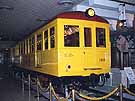
The fully restored 1001, type 1000, the first car of Tokyo Subway. The 1927-built type 1000 was modeled after New York Subway rolling stock in terms of mechanism and performance.

The fully restored 1001, type 1000, the first car of Tokyo Subway. The 1927-built type 1000 was modeled after New York Subway rolling stock in terms of mechanism and performance.
|
By Marcel van Dijk
A little off the beaten tourist track, far beyond the eastern shore
of the Sumida-gawa (the Sumida River) lies the Tokyo Subway Museum. It
is not as well-known as its main competitor, The JR East Railway Museum at Omiya,
but more than worth the visit. Completed 1986, it
shows the full story of Tokyo subways in fascinating detail.
The museum is located very conveniently and appropriately under the
viaduct of the Tokyo Metro (known as 'Eidan' until 2004) Subway Tozai-sen
(the East-west Line), just 100 metres east of Kasai station. I visited the
museum in 1992, going by subway of course, but not aware of the fact that
the eastern end of the Tozai-sen has kaisoku rapid-service trains that bypass
Kasai station! Happily I could get off at the next rapid-service stop and backtrack
without having to pay an additional fare.
The entrance of the museum is done in 'subway-station-style',
complete with automatic ticket gates, to bring the visitors in the
right mood. Once in, the museum starts with an exhibition on the
relationship between the city and the subway over the years, with a
good deal of clear explanation. The old Ueno station of Tokyo's first
subway has been rebuild more or less faithfully, with displays of items
of this very first line from Ueno to Asakusa (forming part of today's
Ginza-sen) opned in 1927.
Next comes a series of more technical exhibitions. The first is on
constructing subway tunnels. Due to the fact that Tokyo lies in a
diluvial plain and certainly complicated by the fact that this is an
earthquake-prone zone, tunnelling is a work that needs to be planned
and done very carefully. Also, the spaghetti-style track work through
the centre of the metropolis and the complicated transfer stations make
addition of new lines more and more complex. The results are extremely
high costs of new lines, only justified if the expected ridership is
also extremely high. However, that is no problem, as we all know!
Attention is also given to the safety of the subway once built, with
anti-flooding devices, and explanations on the traffic- and power
control centres and the indispensable disaster prevention centre.
A 100-series car (#129) is displayed next, in a section covering the
constructing and working of subway cars. You can enter the cab and work
some of the controls (motors, brakes and pantograph). Current
collection by pantograph as well as by third rail and working of
electric motors and brakes in a bogie are shown with real scale
examples.
And last but certainly not least, there is the 'subway playroom'
with three simulators of different subway stock. Normally you can try
one of them under supervision of museum staff (whom I wonder are
volunteering regular Eidan employees with instructing experience?). The
simulators have been used for staff training previously and are a real
joy to work on, but it is certainly no sinecure. It is hard work to
move a fully loaded Tozai-sen train to its tight schedule and to stop
within centimetres of the mark at stations.
The museum has among its facilities a lecture-hall, used for
lectures and showing films, a rest lounge, a library with a good
collection of literature to browse in and a shop with ample supply for
the interested, which in itself is worth the journey, I think.
The museum's address is Tokyo Subway Museum, 6-3-1-Higashi Kasai,
Edogawa-ku, Tokyo 134. Opening times are standard museum opening times,
so closed Mondays. Entry was ¥200 (¥210 as of 2016). It is easily reached by the
Tozai-sen of the subway, Kasai station, but be aware of those kaisoku!
A final note: It seems to be not generally known that besides
railway stations also some Tokyo subway stations have a 'commemorative
stamp'. On my last trip, some 30 could be sampled. Some on expected
tourist locations like Ginza or Asakusa, some on quite unexpected
stations. A nice addition to your collection!
Tokyo Metro Museum Website Current information about the museum, opening times and admission charges.
Photos and their captions are all by Hiroshi Naito. Article updated 01 June 2016 by Anthony Leith.